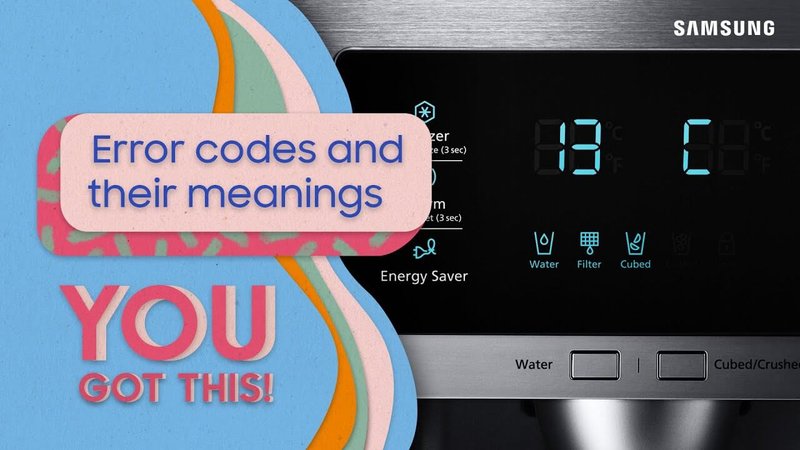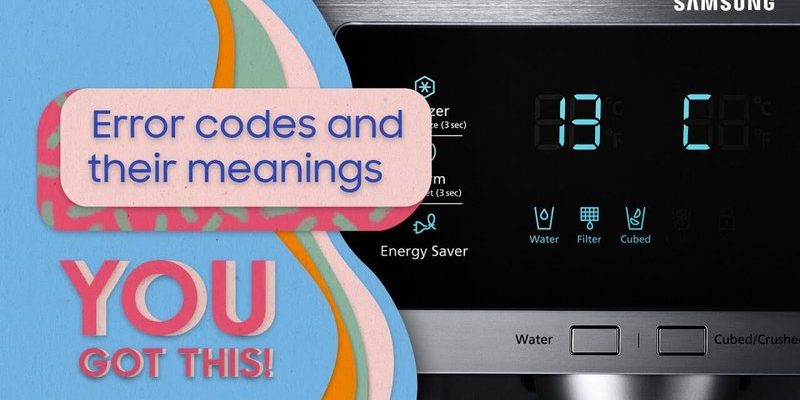
Error codes on your appliances, like the E3 on your Samsung refrigerator, act like a car’s check engine light. They’re hints from your fridge telling you something isn’t quite right. While it might be tempting to disregard it, much like ignoring a persistent rattle in your car, it’s crucial to understand what could be at stake. Ignoring such codes could lead to bigger issues down the line, resulting in costly repairs or even spoiled food. Trust me, no one wants to deal with the smell of spoiled milk or defrosted leftovers.
Understanding Error Code E3
When your Samsung refrigerator flashes error code E3, it’s essentially sending out an S.O.S. indicating a malfunction in its defrosting system. In simple terms, the fridge isn’t cooling properly, and that’s not something you want to overlook. Think of the defrosting system as the refrigerator’s way of keeping itself fresh and functional. If this system fails, it’s as if your fridge develops a cold – it can’t perform at its best.
To break it down a bit more, the E3 code is linked to a failure in defrosting the evaporator coils. These coils are like the veins of your refrigerator’s cooling system, responsible for circulating air. When they frost over, cold air can’t circulate properly, akin to your car’s AC working harder but cooling less effectively. So, ignoring this error is like ignoring a warning sign that your fridge’s performance is stuck in the slow lane.
By understanding this code, you’re equipped to take the right steps in correcting it. Many times, resolving this involves checking the defrost heater, sensor, or timer. But don’t worry, even if that sounds complicated, there are plenty of resources and professional help available to guide you.
Common Causes and Effects of Error Code E3
Just like a detective solving a mystery, figuring out why your fridge is showing an E3 error requires some investigation. The usual suspects include a defective defrost heater, a faulty thermostat, or even a problematic wiring issue. Each of these components plays a crucial role in your fridge’s ability to defrost, and when one falters, it’s like a domino effect leading to inefficiencies.
A common cause is a malfunctioning defrost heater. Think of this heater as your fridge’s personal snow shovel, clearing away unwanted frost. If it stops working, frost builds up, restricting the fridge’s airflow. It’s like trying to run a marathon while breathing through a straw – exhausting and inefficient. Another possible culprit is the thermostat, the little device that reads the temperature and decides when to defrost. If it’s on the fritz, your refrigerator might miss its defrosting cues, again leading to frost buildup.
Ignoring these issues can lead to consequences far worse than just a blinking error code. Your refrigerator’s efficiency plummets, your energy bills might spike, and worst of all, you could be looking at spoiled food and an uncomfortable household. That’s why addressing these underlying causes early can prevent a whole fridge of headaches.
Steps to Resolve Error Code E3
Here’s the deal: fixing the E3 error code doesn’t have to be a daunting task. Sometimes, it’s as simple as resetting your refrigerator or ensuring it has sufficient ventilation. Picture it as rebooting your computer when it freezes – a little reset can go a long way.
Start by unplugging your refrigerator for about five minutes, allowing it to reset itself. If that doesn’t clear the error, the next step is to inspect the defrost components. If you’re handy, you might locate the defrost heater and check for continuity (a fancy term for making sure the electrical circuit is complete). For beginners, though, it might be best to call in a professional to handle any replacements or repairs.
Above all, don’t ignore the code. Taking action at the first sign of trouble can save you from a cascade of fridge problems. And if DIY isn’t your thing, reaching out to Samsung’s customer service or a trusted appliance repair person can be a wise move.
Preventing Future Error Codes
Now, prevention is key to keeping that E3 error at bay. Think of it as regular exercise for your refrigerator – it keeps everything running smoothly and efficiently. Ensure your fridge is not overloaded with items, allowing air to circulate freely. Proper organization isn’t just for your closet; it’s essential for your fridge too.
Moreover, routinely check the door seals to ensure they’re clean and tight. A faulty seal can let warm air in, causing your fridge to work overtime. It’s a bit like leaving your window open with the heater running – wasteful and inefficient. Regular maintenance checks, like inspecting the coils and keeping them clean of dust, can also go a long way.
And, as with many things in life, a little attention goes a long way. By keeping an eye on your refrigerator’s performance, you can catch potential problems before they escalate into costly repairs. So, the next time you see that E3 code, you’ll know just what to do. And trust me, your fridge will thank you for it!
